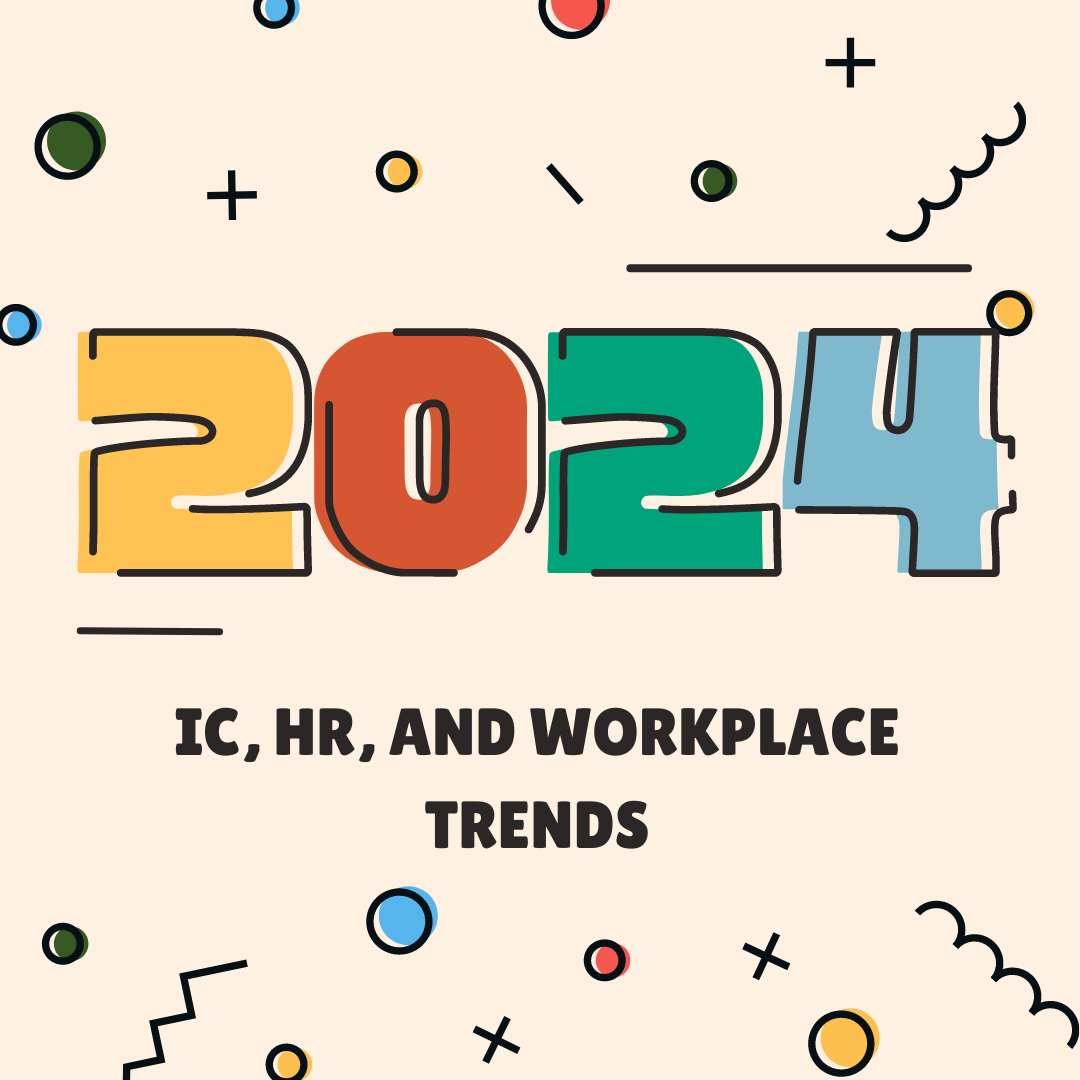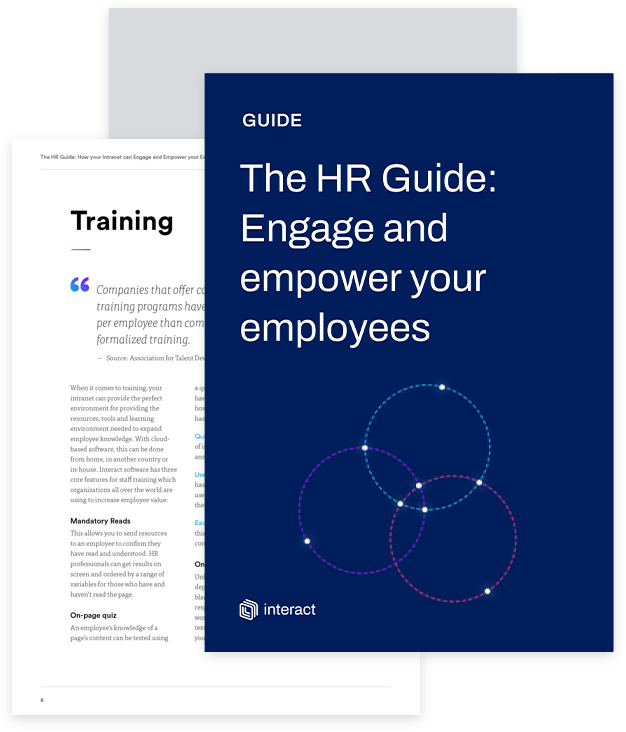Human resources professionals are operating in a time of significant change. With more disruption and transformation on the horizon, Katie Poole, Interact’s Director of HR and Talent, shares the 6 top HR trends and priorities that should be on your agenda in 2023.
Many HR professionals are already thinking about 2023 and the new challenges that await. If you too are planning your HR goals for 2023, you may be starting with the question of how you want your teams to look and work this time next year. To consider that fully though, it’s important to spot the upcoming HR trends so your HR strategy can flex with the times.
Why consider HR trends in your long-term strategy?
Once we remove the organization-specific differences that separate all companies, HR goals share many common factors. We want our workforces to be happy, productive, and connected to the mission, values, and commercial objectives of our organizations.
We know that that doesn’t happen by accident.
Significant organizational change and development occur when we set out a strategic human resources plan and stick to it (as much as possible). Even if you have written them many times before, it’s worth going back to the roots and definition of a human resources strategy. A strategic HR plan lays out how we intend to manage the activities and practices of human capital within an organization.
The CIPD’s definition is this:
“Strategic human resource management (strategic HRM) provides a framework linking people management and development practices to long-term business goals and outcomes.”
Empower and engage your employees – an intranet for HR
This is all true in theory, but it’s also drily technocratic and doesn’t account for the kind of urgent and unexpected changes caused by the pandemic, the Great Resignation, or hybrid work.
In turbulent times, an effective HR strategy must reinforce the long-term goals of business AND consider short-term factors and trends that will change how well people perform. It needs to consider our own objectives in the context of different possibilities.
So, here are 6 HR trends that will influence human resources in 2023. Consider adding them to your strategy when thinking about how you’ll secure more budget, improve your digital workplace, and create a better employee experience for all.
#1. HR priorities for 2023 change as the Great Resignation becomes the Great Breakup
According to 2022’s Women in the Workplace report, the Great Resignation is more nuanced than its blanket name suggests. In what has now been named a “Great Breakup,” women leaders are changing jobs faster and more frequently than their male counterparts. The study found that while male leaders have a voluntary turnover rate of 9%, the rate among women is 10.5%.
There are several contributing factors to this, including lack of opportunity and recognition. One interesting note from the study is confirmation of the idea that female leaders perform more “extracurricular” work than male counterparts. Crucially, they feel this important work – such as DE&I support, working as mental health first aiders, or participating in employee resource groups – is not valued or recognized in performance reviews sufficiently.
HR takeaway – For organizations to avoid disproportionately losing female managers and leaders in 2023, it’s important to consider the context above.
Professional advancement, training, and recognition may help to reverse some of these losses, but so can a focus on flexible working and greater rewards for work that supports employees holistically. Hybrid and flexible working is more important to women than men, for example, which may be something to consider when planning HR priorities for 2023.
Empower and engage your employees – an intranet for HR
#2. Use “job cuffing” to your advantage
If you have never heard of “cuffing” then don’t feel bad, it’s new to many of us. Cuffing comes from the world of dating and relationships and refers to people who “handcuff” themselves to temporary romantic partners for the winter months. Although they want to be involved with someone during the holidays, they are skeptical of the relationship’s long-term potential and typically reassess its validity come spring.
Job cuffing has emerged as a similar trend. Job seekers take up a new role for a season or during a period of economic instability but are unconvinced about their long-term commitment to the company. This could be perceived as a problem for HR leaders because it has the potential to increase staff turnover, increase recruitment costs, and decrease overall productivity.
Knowing about 2023 HR trends such as cuffing can be useful though, as it allows you to factor in seasonal fluctuations in activity.
HR takeaway – If job cuffing becomes more pervasive in 2023, October and March will become periods of exceptional activity for recruitment, onboarding, and offboarding. While you can’t change the external landscape for how easy or difficult it is to recruit, you can avoid planning large HR projects to clash with that time. Knowing that your team could be engaged in the search for talent may leave less time for other initiatives. Creating an employee onboarding checklist in advance may also help to reduce friction at busy times.
#3. Support managers and leaders
Given the dramatic changes everyone has been through since 2020, business leaders and people managers continue to be integral to our organizations. They offer direction for individuals and help to bring communities together when they’re in danger of drifting apart.
According to Gartner’s survey of trends in Human Resource Management, supporting the C-suite and other managers to be visible, empathetic, and connected is the top priority for 2023. The survey showed that 60% of HR leaders consider it a strategic necessity.
How can HR as a function support leaders and managers? One route is through a renewed focus on soft skills, especially communication. Leadership is not an innate trait, it’s a learned set of practices and habits, with communication at the core. Whether they need to give sales updates at your all-hands meetings or record vlogs that engage employees with CSR initiatives, we can support leaders by regularly offering them skills development opportunities.
HR takeaway – Asking people who are already busy to undertake yet more training can be a tricky conversation. Rather than enforcing more training, however, personalized internal communications technologies can target development opportunities so that they reach manager personas more frequently.
If your intranet software supports content personalization based on seniority, it will be possible to create an ongoing campaign of reminders that support your other efforts to engage everyone with professional development.
Empower and engage your employees – an intranet for HR
#4. Change management and the digital workplace
Whether it’s a new IT system or a company rebrand, a typical organization has undertaken five major organizational changes over the past three years. When you add on the manifold global shifts that have transformed how we work, it’s not surprising that many employees are now resistant to more change.
According to Gartner’s 2016 Workforce Change Survey, “74% of employees were willing to change work behaviors to support organizational changes,” but that number dropped to 38% in 2022.
Minimizing “change fatigue” is important because, if left unchecked, it can result in emotional stress, lower productivity, and eventual burnout. Heading off those outcomes in the future means thinking now about how our workplaces use technology to support a smoother employee experience—not a disjointed one.
HR takeaway – Most mid- and large-size enterprises have some form of digital workplace and connected tech stack. And, as needs and realities change, so too does the software. In 2023, you may shift to a new employee benefits app or swap payroll software. When this change happens, it has the potential to generate even more fatigue and anxiety for co-workers. If employees don’t have the right change communications or access to new accounts, for example, they may not be able to access pay slips, which can lower morale.
One common thing that better performing organizations have is a centralized digital platform that facilitates a smooth digital employee experience. By creating a single digital hub with an easily navigable menu – accessible through web browser, responsive experience, and mobile app – they create a single place for employees to perform common daily tasks and access workplace apps without destabilizing change. This removes multiple logins and disconnected apps in favor of a more coherent approach. Your plan may be to change your digital workplace in 2023, but you can also minimize disruption by routing it through a single home built on intranet homepages.
#5. Communicating benefits
Pay, culture, flexibility, and meaningful work will all continue to be factors that attract and retain top talent in 2023. Not all those areas are easily improved though. Culture takes time to change and working practices may be rigid because of the sector and its regulations. On the issue of pay, an unstable economic landscape already means that many organizations have introduced hiring freezes and been forced to communicate layoffs. A hard ceiling on increases in salary or financial benefits may follow too.
In the absence of the salary rises employees may be hoping for, benefits will be more important. You may have some flexibility in your HR priorities for 2023: if so, the smart money seems to be on tailoring benefits around flexibility and providing financial discounts on everyday products and services rather than big-ticket items. Holiday trading or support with travel costs may prove more useful than discounts on luxury hotels.
Before rethinking your entire benefits package for 2023 though, it may be worth working with the internal communications team to understand how much employees really know and understand what is available. A recent UK poll of over 2,500 workers found that just 57% of staff said their employer had communicated about benefits.
HR takeaway – Benefits will become more important if the recent HR trends towards hiring freezes and lower-than-inflation salary increases continue. To save departmental budget (and more change communications), ensure that the benefits you already have are cutting through with everyone in your organization.
If your intranet software has Mandatory Read functionality, you can guarantee that the people you need to target have seen, read, and acknowledged crucial information.
Empower and engage your employees – an intranet for HR
#6. Response frameworks
Companies tend to be good at communicating business updates: new CEO, change of direction, opening an office in a new country—this is all straightforward because it’s factual. However, this gets more difficult for HR and internal communicators when no one is sure how directly an event affects employees.
Should there be crisis comms every time there’s an emergency in a city where you have an office? Does the company need to make a statement about political change or war in another country? How often should you be communicating about DE&I?
Many people will say that some of these matters belong outside a company’s remit and don’t require an organizational response. However, many staff (especially Millennials and Gen-Z workers) do expect employers to take a stand on issues that matter to them, and it can cause disengagement if they feel a company is not living up to its values.
HR takeaway – It’s impossible to cover every situation that may arise, but there have been numerous resources in 2022 aimed at helping internal communicators to develop response frameworks.
By strategically thinking ahead of time about the who, what, when, why, and how of employee communications, you can save time and have a more coherent plan when new news emerges.
Are you ready for 2023’s HR trends?
For many HR professionals, the next 12 months will see challenges increase but budgets and resources stay the same. By looking at the coming trends in Human Resource Management though, it is possible to anticipate future priorities and consider how this will affect our work and communications for the coming year.
Empower and engage your employees – an intranet for HR
*EDIT
In early January 2023, the idea of “quiet hiring” has emerged as a workplace trend for 2023. The idea is not really “new” to organizations who already use freelancers, outsourced labor, and a skills-based approach, but the focus could be an important one for HR.
What is quiet hiring?
As pointed out by Gartner’s workplace analysts, 2022’s labor shortages and difficulties with talent acquisition have not gone away. As a result, many companies are facing delivery challenges with goods or services.
If there aren’t enough teachers, medics, software developers, or carers, how can an organization deliver on its short-term objectives?
The use of contractors or short-term hires has always been in play, but the economic landscape of 2023 may make this more difficult. More scrutiny on spending due to recessions may mean less money for that type of hiring, so companies may need to use leverage the skills of existing employees in different ways.
Quiet hiring in 2023 then may be less about hiring and more about learning what employees can do and how they may be able to move within the company to perform different roles. This will raise the need for HR and others to focus intently on what staff want as well as how they can be used.



